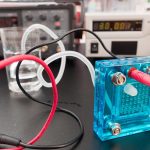
Researchers develop a blood drawing robot that provides rapid test results
Thursday, August 09, 2018 by Edsel Cook
http://www.futuresciencenews.com/2018-08-09-researchers-develop-blood-drawing-robot-that-provides-rapid-test-results.html

The simple but important job of drawing and testing the blood of patients can now be taken over by a robot, an article on News Wise reported. That is because New Jersey-based engineers came up with a fully-automated blood drawing and testing machine that can work much faster than humans in a laboratory.
The robot is intended to speed up the workflow in health institutions like hospitals. Its creators believe it will free up time for healthcare professionals to tend patients instead of performing tedious tasks.
The details of the device are discussed in a study published in the online journal TECHNOLOGY. The senior author is Martin L. Yarmush, a professor at the Department of Biomedical Engineering at Rutgers University–New Brunswick (Rutgers) in New Jersey.
Yarmush explained that his team’s invention integrates miniaturized robotics and microfluidic systems. The robot is as accurate and versatile as conventional means of drawing blood and testing the samples in a full-fledged laboratory. It also enjoys the availability and swiftness of point-of-care testing methods that are conducted at the treatment site.
“This device represents the holy grail in blood testing technology,” Yarmush said. (Related: Chinese AI able to diagnose and identify cancerous prostate samples as well as human doctors.)
Blood drawing and testing could be much faster
Blood testing is the world’s most widely used medical procedure. It is also one of the most important processes when diagnosing a patient. Health professionals make many of their decisions based on the outcome of the laboratory analysis.
In order to achieve the best results, the manual method of drawing blood from a patient requires the clinician to possess a skilled touch. The effectiveness of the process also depends on the physiology of the patient, whose veins might not be very large or visible.
Furthermore, almost all blood tests are performed in large laboratories that are responsible for numerous samples from different clinics and hospitals. The analysis methods at these centralized labs require a lot of labor and time.
Therefore, biomedical engineering researchers at Rutgers developed an automated blood drawing and testing machine that incorporated “lab-on-a-chip” technology. The system consists of a robot that draws blood from veins, a module that handles samples, and a blood analyzer.
The robot is guided by images so that it can overcome the challenge of veins that are difficult to access. Meanwhile, the analyzer is equipped with a centrifuge that can determine the number of blood cells in the sample.
New robot can immediately analyze the blood sample it draws from patients
They put the new device through its initial paces by having the robot practice drawing blood-mimicking fluid from artificial arms with fake blood vessels made out of plastic tubes. The blood-mimicking fluid contained fluorescent microbeads that represented white blood cells.
The machine then performed white blood cell tests on the samples of fake blood. The test counted the number of microbeads in each sample, with the area of the packed bead layer representing the concentration of beads.
The Rutgers researchers reported that the device was very accurate. In addition to expected locations like the clinics, offices, and emergency rooms, they believed the robot could be fitted aboard ambulances or placed at the bedside of a patient.
“When designing the system, our focus was on creating a modular and expandable device,” explained study leader Max Balter, a biomedical engineer. “With our relatively simple chip design and analysis techniques, the device can be extended to incorporate a broader panel of tests in the future.”
Visit FutureScienceNews.com to learn how robots are taking over various important roles in health services. Also see MedicalTech.news.
Sources include:
Tagged Under: Tags: biomedical devices, biomedical tech, blood, blood tests, future tech, inventions, medical robots, medical technology, robotics, robots





